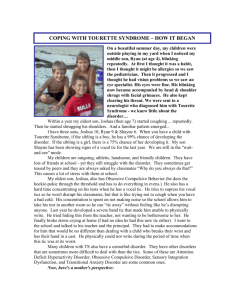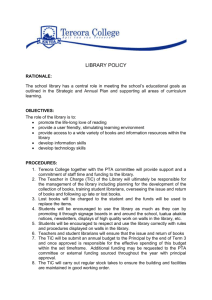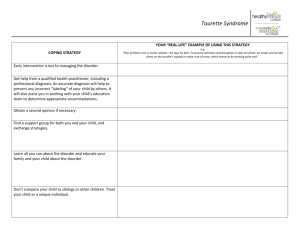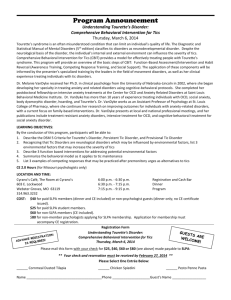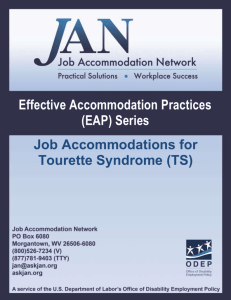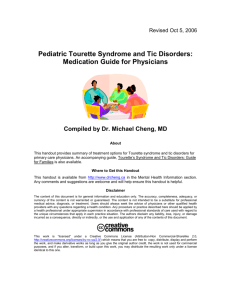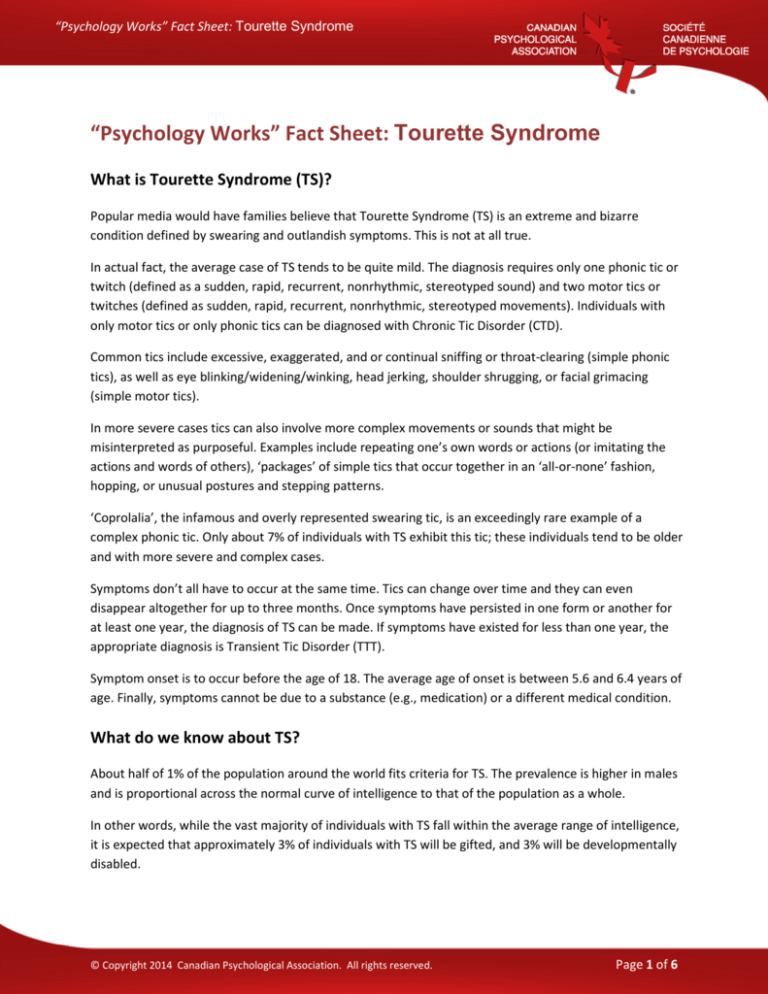
“Psychology Works” Fact Sheet: Tourette Syndrome
“Psychology Works” Fact Sheet: Tourette Syndrome
What is Tourette Syndrome (TS)?
Popular media would have families believe that Tourette Syndrome (TS) is an extreme and bizarre
condition defined by swearing and outlandish symptoms. This is not at all true.
In actual fact, the average case of TS tends to be quite mild. The diagnosis requires only one phonic tic or
twitch (defined as a sudden, rapid, recurrent, nonrhythmic, stereotyped sound) and two motor tics or
twitches (defined as sudden, rapid, recurrent, nonrhythmic, stereotyped movements). Individuals with
only motor tics or only phonic tics can be diagnosed with Chronic Tic Disorder (CTD).
Common tics include excessive, exaggerated, and or continual sniffing or throat-clearing (simple phonic
tics), as well as eye blinking/widening/winking, head jerking, shoulder shrugging, or facial grimacing
(simple motor tics).
In more severe cases tics can also involve more complex movements or sounds that might be
misinterpreted as purposeful. Examples include repeating one’s own words or actions (or imitating the
actions and words of others), ‘packages’ of simple tics that occur together in an ‘all-or-none’ fashion,
hopping, or unusual postures and stepping patterns.
‘Coprolalia’, the infamous and overly represented swearing tic, is an exceedingly rare example of a
complex phonic tic. Only about 7% of individuals with TS exhibit this tic; these individuals tend to be older
and with more severe and complex cases.
Symptoms don’t all have to occur at the same time. Tics can change over time and they can even
disappear altogether for up to three months. Once symptoms have persisted in one form or another for
at least one year, the diagnosis of TS can be made. If symptoms have existed for less than one year, the
appropriate diagnosis is Transient Tic Disorder (TTT).
Symptom onset is to occur before the age of 18. The average age of onset is between 5.6 and 6.4 years of
age. Finally, symptoms cannot be due to a substance (e.g., medication) or a different medical condition.
What do we know about TS?
About half of 1% of the population around the world fits criteria for TS. The prevalence is higher in males
and is proportional across the normal curve of intelligence to that of the population as a whole.
In other words, while the vast majority of individuals with TS fall within the average range of intelligence,
it is expected that approximately 3% of individuals with TS will be gifted, and 3% will be developmentally
disabled.
© Copyright 2014 Canadian Psychological Association. All rights reserved.
Page 1 of 6
“Psychology Works” Fact Sheet: Tourette Syndrome
Initial symptoms are typically simple, of the motor variety, and first appear in the head or facial region.
Symptoms will likely occur in bursts and will wax and wane (i.e. "come and go", or increase and decrease
in severity) over time and environment.
On average, tic severity peaks between the ages of 9 and 11 (Leckman et al., 2006). Most individuals
continue to experience tics into adulthood but the majority of those individuals will experience significant
symptom reduction by that time.
Future tic severity can be predicted by severity and degree of psychosocial stress and depression in
childhood, as well as by fine motor skill deficits in childhood (Bloch et al., 2006).
Individuals can sometimes suppress (i.e. hold in) their tics for short periods of time. The ability to
suppress depends upon such factors as age, cognitive functioning level, awareness of tic symptoms, and
symptom severity.
Suppression of tics becomes an option because the truly involuntary aspect of most tics is the urge to tic
(known as "premonitory urge") rather than the tic itself.
80-93% of individuals with tic disorders aged eight and older report premonitory sensations; evidence
suggests that younger children are likely also experiencing premonitory urges but are less reliable at
noticing and/or reporting them (Woods et al., 2005).
Many individuals with TS will liken this premonitory urge to an "itch" that needs to be "scratched" (by
performing the tic).
Other descriptions of premonitory urges include a "tickle", sensations of warmth or pressure, or
complaints of a certain area of the body not feeling "right" until the tic is performed. This need to satiate
the premonitory urge increases the longer a person suppresses his/her tics, and is relieved upon releasing
the tic. In this way, tics are negatively reinforced (Himle et al., 2007).
TS is a genetic disorder; however, the exact combination of genes involved is not yet fully understood.
Brain imaging suggests structural and neurochemical anomalies in areas of the brain involved in motor
movements; more specifically, the "stop" circuit appears to work improperly.
How can psychological practices be used to treat individuals with tics?
Despite being a neurochemical disorder, there is much that psychology can offer those with tics in terms
of both effective treatment and improved quality of life. Important to note is that diagnoses of TTD, CTD,
and TS differ only in matter of degree (i.e. number, frequency, duration, or severity of tic symptoms). The
underlying understanding and management of these symptoms does not change across diagnosis.
Punishment, Massed Negative Practice, and Suppression are not Viable Treatment Options. The ability to
'hold in' all symptoms on demand is imperfect, conscious, exhausting, and irritating. It consumes
considerable internal resources, causing omission errors in other work (Woods et al., 2008). Attention,
ability to focus, energy levels, social awareness, and frustration tolerance can all be negatively influenced
© Copyright 2014 Canadian Psychological Association. All rights reserved.
Page 2 of 6
“Psychology Works” Fact Sheet: Tourette Syndrome
by suppression. Pressure from others to suppress will in all likelihood increase rather than decrease tic
symptoms.
Habit-Reversal Therapy (HRT) is a form of behaviour therapy that was identified in 2007 as meeting the
American Psychological Association (APA)'s criteria to be considered a 'well-established', evidence-based
practice in the treatment of tic symptoms (Cook & Blacher, 2007). In HRT, a unique "competing response"
is used to extinguish a target tic.
Competing responses are actions that are physically incompatible with target tics, more benign that the
original symptoms, and which can be sustained for minutes at a time if necessary (until the urges pass).
Optimally, a competing response is used each time the premonitory urge arises for that particular tic, or
when entering into a situation which typically elicits that tic. Using the competing response after a tic has
‘escaped’ is also recommended to prevent a subsequent symptom burst.
Only one tic should be targeted at a time. After an initial intense period of a few days, the target tic will
decrease dramatically. Vigilance is key, as multiple spontaneous recoveries of the symptom will occur,
each shorter and at a more reduced level. Over time, target symptoms can be completely extinguished
from the individual’s repertoire.
HRT has the advantage of avoiding significant side effects that can be associated with medications
typically used to treat tics. HRT also empowers individuals with tic disorders to select which symptoms
they wish to eliminate and thus to ‘tailor’ their own treatment.
The Comprehensive Behavioural Intervention for Tics (CBIT). In 2008 a consortium of researchers
completed a multi-site, multi-million dollar study funded by the National Institute for Health (NIH) to
investigate multiple behavioural treatments for tics. This flagship study combined HRT with
psychoeducation, function-based intervention, relaxation training, and social support into a treatment
called CBIT.
A large sample of youth aged nine to seventeen years who were diagnosed with tics and many other
comorbid disorders (e.g. ADHD, OCD) were tested. Improvement in tics, and overall effect sizes obtained,
were comparable to gains seen in medication trials. These significant gains were seen despite the fact
that 2/3rds of the sample were already taking a medication to treat their tics, and despite the fact that
the comparison group was also receiving components of the treatment (psychoeducation, social support).
Most medication studies ensure that participants receive the experimental treatment alone, and control
subjects receive absolutely no treatment at all, in order to maximize the effect size and statistical
significance.
Psychoeducation is often the only treatment needed. Individuals with tics regularly report that reactions
to their tic symptoms are more problematic than the tic symptoms themselves. Symptoms of TS can
easily lead to misperceptions, ridicule, stigmatization, and social ostracization.
© Copyright 2014 Canadian Psychological Association. All rights reserved.
Page 3 of 6
“Psychology Works” Fact Sheet: Tourette Syndrome
Proactively informing peers, teachers, parents or co-workers about TS through school assemblies or staff
presentations is therefore an extremely important component of initial care; in fact, a thorough
demystification can even diminish any further need for treatment at all.
Psychology can also help with neurodevelopmental conditions commonly comorbid with TS. For example,
Obsessive-Compulsive Disorder (OCD) is a condition that occurs in anywhere from 28-67% of TS cases.
Exposure & Response Prevention (ERP) is a highly effective treatment approach for OCD.
Tips and t(r)ic(k)s
Two factors that are known to exacerbate tic symptoms are increased concentration on symptoms (which
can result in an individual paradoxically engaging in certain symptoms at increased levels once these
symptoms are suggested or his or her attention is drawn to those symptoms) and stress. Stress in this
context would include eustress (e.g. excitement over an upcoming positive event) as well as distress (e.g.,
being hungry/tired/frustrated/hot, in a large crowd).
In preparation for the diagnostic appointment, parents are strongly advised to keep a diary of symptoms
and to audio or video-record symptoms. This is because children will often suppress their tics with in the
psychologist’s or physician’s office, which may delay proper diagnosis.
TS rarely occurs in isolation. Other neurodevelopmental conditions which commonly co-occur with TS are
Attention-Deficit/Hyperactivity Disorder (ADHD), Obsessive-Compulsive Disorder (OCD), Learning
Disorders, and sensory processing dysfunctions.
When an individual must contend with many or all of this dysregulation without treatment or
accommodation, other problems can begin to appear (anxiety, demoralization, sleep difficulties,
oppositional/defiant behaviour and intermittent explosions (‘rage’).
While these secondary symptoms are often the paramount reasons for pursuing treatment, focusing on
treatment of the TS and associated neurodevelopmental conditions tends to be a better treatment of
these secondary symptoms than targeting them directly.
Stimulant medications do not cause tic disorders. Contrary to popular belief, stimulant medications
commonly used in the treatment of ADHD (e.g. Ritalin, Concerta, Adderall, Biphentin) do not always
exacerbate tic symptoms. Many individuals find their tic symptoms unchanged or even improved with the
use of stimulant medication (Gadow et al., 2007). Others find that all tic exacerbations as a result of
stimulant use can be reversed or decreased as a function of either dosage or stimulant used (Castellanos
et al., 1997). At this time there is no definitive evidence to indicate that stimulant medications can cause
the emergence of tics (Pidsosny & Virani, 2006), and a 2005 consensus statement by the Global ADHD
Working Group indicated that the incidence of tics does not increase significantly in most patients when
treated with stimulants (Remschmidt, 2005).
© Copyright 2014 Canadian Psychological Association. All rights reserved.
Page 4 of 6
“Psychology Works” Fact Sheet: Tourette Syndrome
References
•
•
•
•
•
•
•
•
•
Bloch, MH; Sukhodolsky, DG; Leckman, JF; Schultz, RT. (2006). Fine-motor skill deficits in
childhood predict adulthood tic severity and global psychosocial functioning in Tourette's
syndrome. Journal of Child Psychology and Psychiatry, 47(6), 551-559.
Castellanos, FX; Giedd, JN; Elia, J; Marsh, WL; et al. (1997). Controlled stimulant treatment of
ADHD and comorbid Tourette's syndrome: Effects of stimulant and dose. Journal of the American
Academy of Child & Adolescent Psychiatry, 36(5), 589-596.
Cook, CR & Blacher, J (2007). Evidence-Based Psychosocial Treatments for Tic Disorders. Clinical
Psychology: Science and Practice, 14(3), 252-267.
Gadow, KD; Sverd, J; Nolan, EE; Sprafkin, J; Schneider, J. (2007). Immediate-Release
Methylphenidate for ADHD in Children with Comorbid Chronic Multiple Tic Disorder. Journal of the
American Academy of Child & Adolescent Psychiatry, 46(7), 840-848.
Himle, MB; Woods, DW; Conelea, CA; Bauer, CC; Rice, KA. (2007). Investigating the effects of tic
suppression on premonitory urge ratings in children and adolescents with Tourette's syndrome.
Behaviour Research and Therapy, 45, 2964-2976.
Leckman, JF; Bloch, MH; Scahill, L; King, RA. (2006). Tourette Syndrome: The Self Under Siege.
Journal of Child Neurology. Special Issue: Tourette Syndrome, 21(8), 642-649.
Pidsosny, IC; Virani, A. (2006). Pediatric Psychopharmacology Update: Psychostimulants and Tics Past, Present and Future. Journal of the Canadian Academy of Child and Adolescent Psychiatry,
15(2), 84-86.
Remschmidt, H. by the Global ADHD Working Group (2005). Global consensus on ADHD/HDK.
European Child & Adolescent Psychiatry, 14, 127-137.
Woods, DW; Piacentini, J; Himle, MB; Chang, S. (2005). Premonitory Urge for Tics Scale (PUTS):
Initial Psychometric Results and Examination of the Premonitory Urge Phenomenon in Youths with
Tic Disorders. Developmental and Behavioral Pediatrics, 26(6), 397-403.
Where do I go for more information?
For more information visit the following websites:
•
•
The Tourette Syndrome Foundation of Canada at http://www.tourette.ca.
"Life’s a Twitch!" at http://www.lifesatwitch.com. Film available from the National Film Board
at http://www.nfb.ca.
•
"I Have Tourettes, but Tourettes Doesn’t Have Me". Produced by Home Box Office (HBO) and the
Tourette Syndrome Association (30-minute DVD).
Tourette's Syndrome: Finding Answers & Getting Help." Mitzi Waltz.
and
•
You can consult with a registered psychologist to find out if psychological interventions might be of help
to you. Provincial, territorial and some municipal associations of psychology often maintain referral
© Copyright 2014 Canadian Psychological Association. All rights reserved.
Page 5 of 6
“Psychology Works” Fact Sheet: Tourette Syndrome
services. For the names and coordinates of provincial and territorial associations of psychology, go to
http://www.cpa.ca/public/whatisapsychologist/PTassociations/.
This fact sheet has been prepared for the Canadian Psychological Association by Dr. B. Duncan
McKinlay, Brake Shop Clinic, CPRI, Ministry of Children & Youth Services; Adjunct Clinical Professor,
Department of Psychology (UWO); Adjunct Faculty Member, Departments of Psychology (UofG); Lecturer,
Department of Psychiatry (UWO).
January 2009
Your opinion matters! Please contact us with any questions or comments about any of the Psychology
Works Fact Sheets: factsheets@cpa.ca
Canadian Psychological Association
141 Laurier Avenue West, Suite 702
Ottawa, Ontario K1P 5J3
Tel: 613-237-2144
Toll free (in Canada): 1-888-472-0657
© Copyright 2014 Canadian Psychological Association. All rights reserved.
Page 6 of 6

